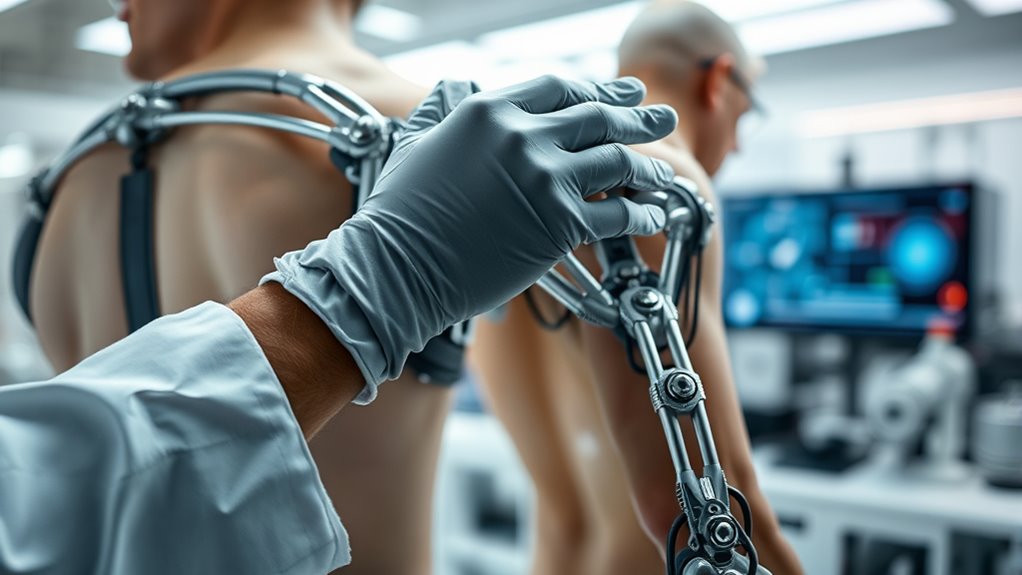AI is transforming exoskeletons into smarter, safer devices by actively adapting to your body and environment. It processes real-time sensor data to improve comfort, stability, and safety, while advanced vision sensors help detect obstacles and navigate complex terrains. Machine learning personalizes support and adjusts on the fly, making exoskeletons more natural and effective. As AI continues to evolve, staying informed will reveal the exciting ways these innovations are changing mobility solutions for everyone.
Key Takeaways
- AI enables real-time sensor data processing to adapt exoskeleton support to user movement and environmental conditions.
- Machine learning algorithms personalize device support based on individual gait patterns and activities.
- AI enhances safety by detecting obstacles and environmental hazards proactively for user protection.
- Development accelerates through AI-driven clinical trials and simulation training, reducing time and costs.
- IoT integration and data security measures ensure remote monitoring, updates, and user data protection.

Artificial intelligence is transforming the development of exoskeletons by making them smarter, safer, and more responsive. When you wear an AI-powered exoskeleton, it doesn’t just move you—it actively adapts to your body and environment. AI enhances mobility by mimicking natural human movements, helping individuals with impairments regain independence. It processes vast amounts of real-time data from sensors to make instant adjustments, guaranteeing your stability and comfort as you walk across different terrains. Advanced sensors, including vision sensors, improve the device’s interaction with the environment, adding layers of safety and functionality. This integration allows the exoskeleton to detect obstacles, uneven surfaces, and other environmental factors, so it can respond proactively rather than reactively.
Thanks to ongoing clinical trials, companies like Wandercraft are refining these systems for practical, everyday use. These innovations are reducing the need for extensive human testing, which accelerates development and lowers costs. As a result, AI-supported exoskeletons become more accessible and affordable, opening new possibilities for many users. The core of this technology lies in advanced machine learning algorithms that enable the exoskeleton to handle complex terrains such as stairs, slopes, and uneven ground. These algorithms allow the device to learn from each user’s specific gait and needs, providing personalized support and making adjustments on the fly. Additionally, training data plays a crucial role in improving these algorithms’ accuracy and reliability over time.
You’ll also benefit from real-time data processing, which guarantees safe navigation and smooth movement transitions. As you move, AI continuously analyzes your posture, muscle activity, and environmental cues to optimize support, reducing physical strain and preventing injuries. AI’s ability to customize support means the exoskeleton adapts to your unique needs, whether you’re walking long distances or performing delicate tasks. In industries like healthcare, logistics, and construction, these systems are already making a substantial impact by improving productivity, reducing worker fatigue, and enhancing safety measures. For individuals with mobility challenges, AI exoskeletons offer increased accessibility, empowering them to participate more fully in daily activities.
Technological advances include simulation training, where AI autonomously learns ideal control strategies, and learned controllers that deliver smooth torque assistance without manual calibration. These improvements not only boost ergonomics but also greatly enhance energy efficiency, making devices last longer on a single charge. Integration with IoT platforms enables remote monitoring and updates, expanding the potential for future innovations. Overall, AI’s role in developing exoskeletons is pivotal, transforming these devices into sophisticated tools that are safer, more adaptable, and more capable of improving lives across various industries. Additionally, leveraging trusted custodians ensures proper management and security of the data collected during operation, which is crucial for compliance and user safety. Furthermore, ongoing research into AI safety measures helps address vulnerabilities and bias concerns, ensuring these advanced systems remain reliable and trustworthy.
Moreover, understanding the materials science behind exoskeleton construction contributes to developing lighter and more durable devices, which enhances user comfort and device longevity. A promising area of research involves biomimicry, where engineers design exoskeletons that imitate natural muscle and joint movements to improve performance and comfort.
Frequently Asked Questions
How Does AI Improve Exoskeleton User Comfort?
You can experience improved comfort because AI dynamically adjusts your exoskeleton support based on your movements and strain. It uses sensors to gather real-time data, allowing precise, personalized support that fits your body better. AI also learns from your activity patterns over time, optimizing settings for your comfort. This adaptive approach reduces fatigue and makes movements feel more natural, so you can focus on your tasks with less discomfort.
What Are the Ethical Considerations of Ai-Controlled Exoskeletons?
When contemplating AI-controlled exoskeletons, you need to understand the ethical issues involved. You must guarantee user autonomy, prevent data misuse, and address potential biases or unfair advantages. You’re responsible for making sure the AI respects your commands, maintains transparency, and protects your privacy. It’s also crucial to evaluate the social implications, like fair access and long-term effects on your physical and psychological well-being, to use this technology ethically.
Can AI Adapt to Different Users’ Movement Patterns?
Think of AI as a chameleon, blending seamlessly with your unique movement patterns. It adapts in real-time, sensing subtle shifts in your physiology and adjusting assistance accordingly. You’ll notice smoother, more natural support as the system learns your habits, whether you’re climbing stairs or lifting heavy loads. This dynamic responsiveness guarantees the exoskeleton feels like an extension of you, personalized to your every step and movement nuance.
How Secure Is Data Collected by AI Exoskeletons?
You’re wondering how secure the data collected by AI exoskeletons is. The security depends on measures like encryption, secure cloud storage, and strict access controls. While these systems often anonymize data to protect privacy, vulnerabilities still exist, especially in cloud platforms prone to cyber threats. Regular updates and strong security protocols are essential to keep your personal information safe and prevent unauthorized access.
What Future AI Innovations Could Enhance Exoskeleton Functionality?
They say the future is always evolving, and AI innovations will keep pushing exoskeletons forward. You can expect more advanced algorithms, real-time data analysis, and better integration with sensors like vision tech. These advancements will make exoskeletons more adaptable, offering improved stability, natural movements, and versatility across various tasks. As technology progresses, you’ll find these devices becoming even smarter, safer, and more responsive to your needs.
Conclusion
As you step into the future, remember that AI is revolutionizing exoskeletons faster than you can say “H.G. Wells.” With smarter designs and adaptive tech, these devices will soon feel like your own personal Iron Man suit. Embrace the change, because AI’s role isn’t just about machines; it’s about empowering you to push past limits once thought impossible. The future’s here—don’t get left behind in the Stone Age of innovation.










